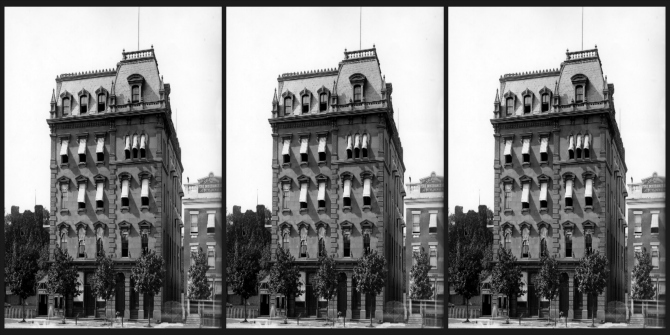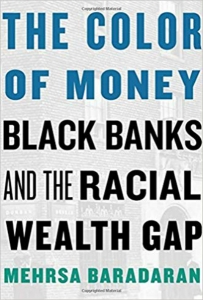
The Color of Money: Black Banks and the Racial Wealth Gap. Mehrsa Baradaran. Harvard University Press. 2017.
Mehrsa Baradaran’s The Color of Money studies the role of financial structures in the American racial wealth gap. Noting that 60% of black Americans — relative to 20% of white Americans — are either unbanked or underbanked, Baradaran describes how depictions that attribute such inequality simplistically to racism ignore the colossal impact of the much subtler forces of ‘commerce, credit, money and segregation’ that underpin it, which have played a largely silent role in the wealth gap that characterises contemporary US society.
Black banking has its origins in the small military banks which formed during the Civil War in the 1860s to hold the wages of black soldiers. A particularly important example in this regard is that of the Freedman’s Bank, which was seen by the public as trustworthy because it was backed by Abraham Lincoln’s government but was actually run as a private investment bank with management personnel actively engaged in speculation. This strategy was facilitated by the black community’s willingness to use the institution as a ‘piggy bank’ as its management sought to inculcate the values of thrift and capitalism.
Baradaran emphasises that the most salient feature of capitalism is the ability of capital to proliferate through credit; but the Freedman’s Bank did not allow the black community to avail this feature as it did not lend to depositors. Eventually, the bank collapsed after incurring massive losses because its management used customer deposits to finance the westward expansion of the railroad, or what has been called the ‘first postwar asset bubble’. For many in the black community, the collapse of this institution caused financial ruin and led to a deep mistrust of state institutions as well as banks in general. But the case for black banking prevailed not only because many black leaders — some who had worked in the bank as tellers, clerks and bookkeepers — saw the potential for success, but also because the legitimisation of Jim Crow laws and segregation effectively eliminated the black community from public life in America. In this racially segregated setting, ‘not only was it impossible for black banking to be separate and equal, they could not even be separate and profitable’.
There were many structural reasons for this: for instance, even though the number of black businesses increased exponentially between 1917 and 1930, because these were almost always individually owned and closed when the founder died they offered only a weak infrastructure for the production and accumulation of capital. Also, since the black community could not receive credit or insurance from a white bank or purchase a home from a white realtor, the cost of accumulating capital was always higher. And prohibitions made it necessary for black businesses to find black customers, whereas white businesses could sell their goods to anyone: as a result, black businesses competed with other black businesses as well as white businesses and thus struggled to achieve economies of scale.
The disadvantage that black people have faced in home ownership is at the crux of the wealth gap. White banks did not generally lend to black people, and even when they did, the interest rate was much higher than usual. The portfolios of black banks came to be engorged by home loans: this placed the banks in a precarious situation because the nature of segregation was such that when black people purchased property, house value fell and thus compromised loan collateral. This curious phenomenon added an economic impetus — in addition to a racist one — to the vociferous efforts of white people to keep black people out of their neighbourhoods, as the fear of a neighbourhood declining and being ‘swallowed up by the ghetto’ was a pressing concern.
The successes of the Civil Rights movement that gained enormous traction in the 1960s meant that the black community was granted equality in the form of legal and political rights; economic equality, however, remained elusive. When President Nixon took office in 1969, a radical black movement faced a strong white backlash: Nixon’s politically savvy response included ‘opposing all forms of legal race discrimination while rejecting any government efforts at integration’. Black banking thus came to be a crucial feature of black capitalism: this was presented as a programme of the government to address the black community’s demands.
But black capitalism could not resolve the problem of capital for black banks: these had no choice other than to make risky loans, face higher costs and lower profits and also strain to attract capital for investment. Additionally, because in order to be classified as a black bank the majority of shareholders had to be black, this limited the opportunity to raise capital as the potential pool of investors for black banks was relatively small. Another problem was deposit volatility because black banks tended to see deposit withdrawals at a higher and frequent rate relative to white banks: to offset risks, volatile deposits needed to be backed by government securities, which offered a low return and cut profitability.
The problem of capital in a segregated banking system is, as Baradaran demonstrates, particularly one of circulation: funds deposited in a black bank eventually leave the black banking system:
“Black banks were still exporting funds from the ghetto. Their over-investment in government securities meant that they were using their customer deposits to finance mortgages outside their communities. During the era of secondary mortgage markets, the outflow of deposit funds into other people’s mortgages was accelerated by the mortgage-backed security. Now, banks anywhere were investing the mortgages everywhere. For black banks, this process was a newer and less obvious way for them to serve as financial sieves — dispersing funds from the ghetto to the broader economy. ( 245)”
Black borrowers had for generations been allowed only limited access to loan markets, so it is unsurprising that this community became the worst victims of the subprime era: according to some estimates, over 53% of total black wealth was destroyed because of the financial crisis in 2008. Since the crisis, black banking has, with some exceptions, been in a state of decline.
Baradaran’s book is thus a historical commentary on wealth inequality in the context of racial discrimination, but it also contains rich material on other themes. These include the political economy of financial institutions, the role of property ownership in replicating inequalities and the concept of self-help as an alternative to structural change. All of these are interrelated and — particularly in an Anglo-American setting — extremely current, given austerity policies amidst the accelerating decline of the post-war welfare state and the state-led emphasis (especially in Britain) on ‘workfare’ and asset-based welfare such as ‘Help to Buy’. Additionally, the discussion may be extended to poor countries: many observations about the inability of black banks to be a mechanism of wealth accumulation speak directly to critical assessments about the limitations of microfinance and financial inclusion strategies in the Global South.
♣♣♣
Notes:
- This blog post appeared originally on LSE Review of Books.
- The post gives the views of its author, not the position of LSE Business Review or the London School of Economics.
- Featured image by US Capitol Visitor Center Wikipedia Public Domain
- When you leave a comment, you’re agreeing to our Comment Policy.
Juvaria Jafri is a PhD candidate at City, University of London. Her previous degrees are from SZABIST, Karachi, Pakistan, and the University of Toronto, Canada. Her doctoral research is on the political economy of inclusive finance and financial citizenship in Pakistan.


